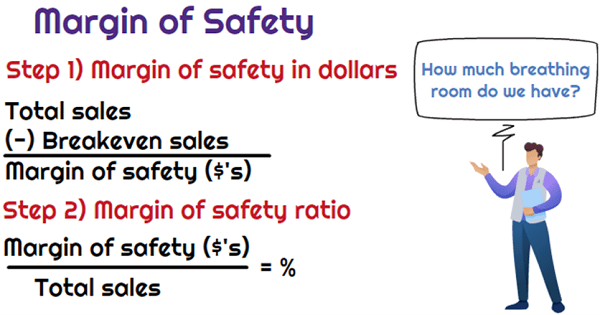Margin safety- Margin safety refers to the level of financial cushion or security that an individual or business maintains to cover unexpected or adverse events. It is essentially a measure of how much “breathing room” you have between your current financial situation and a potential financial crisis. Margin safety can apply to personal finances, investments, or business operations.
Here are a few contexts in which margin safety is important:
- Personal Finance: In personal finance, margin safety means having enough savings or emergency funds to cover unexpected expenses like medical bills, car repairs, or job loss without jeopardizing your financial stability. Financial advisors often recommend having three to six months’ worth of living expenses saved as an emergency fund.
- Investing: In investing, margin safety is about not over-leveraging your investments. It involves maintaining a certain level of equity in your investment portfolio to withstand market downturns without facing margin calls or significant losses. Diversifying your investments can also improve margin safety by spreading risk.
- Business Operations: For businesses, margin safety involves maintaining a healthy profit margin and having enough working capital to cover operational expenses, debt obligations, and unexpected setbacks. It’s essential for a business to have sufficient cash flow and reserves to navigate through challenging times.
- Real Estate: In real estate, margin safety for property investors means not overextending on mortgage debt. It’s about ensuring that rental income covers mortgage payments and other expenses with room for unexpected costs and vacancies.
- Manufacturing and Production: In manufacturing, margin safety involves maintaining excess capacity or inventory to handle fluctuations in demand or supply chain disruptions. This helps prevent production delays and ensures consistent customer service.
- Project Management: In project management, margin safety refers to adding buffers to project timelines and budgets to accommodate unforeseen delays or cost overruns. It helps mitigate risks and ensures project success.
To assess margin safety, individuals and businesses should conduct financial stress tests and risk assessments. This involves evaluating potential risks and determining whether there is sufficient liquidity, cash reserves, or insurance coverage to handle those risks without causing financial distress.
Having a comfortable margin of safety is a fundamental principle of financial planning and risk management, as it provides a safety net to protect against unforeseen events and allows for more stable and sustainable financial and business operations.
What is Required Margin safety
The term “Required Margin Safety” typically refers to the minimum margin of safety that an investor or trader should maintain in their investment or trading activities. It’s essentially the level of cushion or buffer necessary to manage risks and potential losses effectively. The required margin safety can vary depending on the specific investment strategy, risk tolerance, and financial goals of an individual or organization.
Here are a few key points to consider regarding required margin safety:
- Risk Tolerance: The required margin safety is closely related to an individual’s or organization’s risk tolerance. Some investors are more risk-averse and may require a larger margin of safety to feel comfortable, while others with a higher risk tolerance may be comfortable with a smaller margin.
- Investment Strategy: Different investment strategies require varying levels of margin safety. For example, a conservative, long-term investor may prioritize capital preservation and, therefore, require a larger margin of safety. On the other hand, a speculative trader engaged in high-risk, short-term trades may tolerate a smaller margin of safety.
- Asset Class: The type of assets being invested in can impact the required margin safety. For instance, stocks and cryptocurrencies tend to be more volatile than bonds or real estate, so investors in the former may need a larger margin of safety.
- Leverage: If an investor or trader is using leverage (borrowed money) to amplify their positions, the required margin safety should be higher. This is because leverage increases the potential for both gains and losses.
- Market Conditions: Market conditions and economic factors can influence the required margin safety. During periods of economic uncertainty or high market volatility, investors may opt for a larger margin of safety to account for the increased risks.
- Investment Goals: The specific financial goals and time horizon of an investor or organization will also play a role. Those with long-term goals, such as retirement planning, may prioritize a larger margin of safety to ensure their investments can withstand market fluctuations over many years.
To determine their required margin safety, individuals and organizations should conduct a thorough assessment of their financial situation, risk tolerance, investment strategy, and objectives. This often involves working with financial advisors or experts who can help tailor a strategy that aligns with these factors.
Ultimately, the required margin safety is a personalized measure, and what may be appropriate for one person or entity may not be suitable for another. It’s important to strike a balance between achieving financial goals and managing risk effectively.
Who is Required Margin safety
“Required Margin Safety” is not the name of a person or a specific individual. It’s a financial concept or term used in the context of investments, trading, and risk management, as described in the previous responses. It represents the minimum margin of safety or buffer that an investor or trader should maintain to protect themselves against potential losses and risks associated with their investment or trading activities. It’s not the name of a person or an entity but rather a guideline or principle for managing financial risk.
“Margin safety” is not a specific person or entity. It’s a financial concept and term that refers to the level of financial cushion or margin of safety that an individual, business, or investor should maintain to mitigate risks and unexpected financial setbacks. It’s not associated with any particular individual or organization; rather, it’s a principle used in financial planning, risk management, and investing to ensure that there is a buffer or safety net in place to protect against adverse events and losses.
When is Required Margin safety

“Required margin safety” is not a specific point in time. Instead, it is a concept that is relevant whenever you are making financial decisions, especially in the context of investing or trading. It refers to the ongoing need to maintain a sufficient margin of safety in your financial activities to manage risks effectively.
You should consider your required margin of safety whenever you:
- Make Investment Decisions: Before investing in stocks, bonds, real estate, or any other assets, you should assess the level of risk associated with your investment and ensure that you have an appropriate margin of safety in place.
- Manage a Portfolio: If you have an investment portfolio, regularly review it to ensure that your overall risk exposure aligns with your risk tolerance and financial goals. Adjust your investments as necessary to maintain the required margin of safety.
- Use Leverage: If you’re trading on margin or using leverage to amplify your investments, you need to be particularly cautious and maintain a larger margin of safety to cover potential losses resulting from leverage.
- Plan for Emergencies: In personal finance, your required margin of safety should be considered when establishing an emergency fund or insurance coverage to protect against unexpected financial setbacks.
- Assess Business Operations: Business owners and managers should continuously evaluate their company’s financial health and ensure that there is a margin of safety in place to handle operational challenges, economic downturns, and unforeseen expenses.
- Project Management: In project management, you should factor in a margin of safety when setting project timelines and budgets to account for potential delays or cost overruns.
In essence, required margin safety is a principle that should be applied whenever you make financial decisions to ensure that you are adequately prepared for risks and uncertainties that may arise at any point in time. It’s not a fixed event but an ongoing consideration in financial planning and risk management.
Where is Required Margin safety
“Required margin safety” is not a physical location or a tangible object; it’s a financial concept and strategy. It’s not something that exists in a specific place. Instead, it’s a principle used in financial planning, investing, and risk management.
When we talk about “where” it is, we are referring to the context in which it is applied. Required margin safety is a concept that applies to various aspects of personal finance, investing, trading, and business operations. It’s essentially a way to ensure that you have a financial cushion or buffer in place to handle unexpected events or risks.
You apply the concept of required margin safety in your financial decisions, whether it’s in your investment portfolio, personal savings, business operations, or any other financial aspect. It’s a guideline to help you make informed choices and manage financial risks effectively. So, it’s not something you can physically locate but a strategy you implement in your financial planning and decision-making.
How is Required Margin safety
“Required margin safety” is not a specific process or action you can perform; rather, it’s a financial principle or concept that guides your decision-making and risk management in various financial activities. It represents the level of financial cushion or buffer you need to have in place to protect against unexpected losses or risks. Here’s how you can apply the concept of required margin safety:
- Assess Your Financial Situation: Start by evaluating your current financial position, including your assets, liabilities, income, and expenses. Understand your financial goals, risk tolerance, and investment horizon.
- Determine Risk Tolerance: Assess your willingness and capacity to take on risk. Your risk tolerance will influence the level of margin safety you need. Risk-averse individuals may require a larger margin of safety.
- Set Investment or Financial Goals: Clearly define your financial objectives, whether it’s saving for retirement, buying a home, or growing your investment portfolio. Your goals will shape your investment strategy and margin safety requirements.
- Create an Emergency Fund: In personal finance, one way to implement margin safety is by establishing an emergency fund. This fund should cover several months’ worth of living expenses, providing a financial safety net in case of unexpected events like medical emergencies or job loss.
- Diversify Investments: In investment, diversification is a risk management strategy. Spread your investments across different asset classes and industries to reduce concentration risk and increase margin safety.
- Avoid Overleveraging: If you’re involved in trading or investment using borrowed money (leverage), be cautious. Avoid excessive leverage, as it can amplify both gains and losses, reducing your margin of safety.
- Regularly Review and Rebalance: Periodically review your investment portfolio, financial plan, or business operations. Adjust your strategies and allocations as needed to maintain the required margin of safety.
- Consider Insurance: In addition to an emergency fund, consider insurance coverage, such as health insurance, life insurance, or property insurance, to protect against specific risks.
- Stress Testing: Conduct stress tests on your financial plans or investments. Simulate adverse scenarios to see how your financial situation would fare and make adjustments accordingly.
- Consult with Financial Professionals: Seek advice from financial advisors or experts who can help you tailor your financial strategies and margin safety requirements based on your unique circumstances.
Remember that the specific level of required margin safety will vary from person to person and from one financial situation to another. It’s important to customize your approach based on your individual goals, risk tolerance, and financial circumstances. The goal is to ensure that you have a financial buffer in place to weather unexpected challenges and uncertainties.
Case Study on Margin safety
Sarah’s Margin Safety Strategy
Background: Sarah is a 35-year-old professional who works in marketing. She has been diligently saving and investing for her financial goals, which include retirement, buying a home, and building wealth. Sarah has a moderate risk tolerance and believes in a balanced approach to investing.
Financial Situation:
- Annual Income: $80,000
- Emergency Fund: $10,000 (covers 6 months of living expenses)
- Retirement Savings: $100,000 in a diversified portfolio of stocks and bonds.
- Investment Portfolio: $50,000, diversified across stocks, bonds, and real estate investment trusts (REITs).
Goals:
- Retirement: Sarah plans to retire at age 65 and aims for a comfortable retirement lifestyle.
- Home Purchase: She intends to buy a home within the next 5-7 years.
- Wealth Building: Sarah wants to continue growing her wealth over time.
Margin Safety Strategy:
- Emergency Fund: Sarah maintains a well-funded emergency fund of $10,000, which provides her with a safety net for unexpected expenses, such as medical emergencies or job loss.
- Diversified Portfolio: She has structured her investment portfolio to include a mix of assets, including stocks, bonds, and real estate, to spread risk and reduce the impact of market fluctuations. This diversification helps protect her investments during market downturns and provides a margin of safety against significant losses.
- Regular Contributions: Sarah consistently contributes to her retirement and investment accounts each month. This disciplined approach ensures she is continually building her wealth and maintaining a margin of safety through regular savings.
- Risk Management: Given her moderate risk tolerance, Sarah avoids overly speculative or high-risk investments. She prioritizes stability and long-term growth over short-term gains.
- Periodic Review: Sarah reviews her portfolio annually and rebalances it as needed to align with her financial goals and risk tolerance. She adjusts her asset allocation to ensure it remains in line with her desired margin safety level.
- Insurance: Sarah carries appropriate insurance coverage, including health insurance and disability insurance, to protect against health-related risks that could impact her ability to work and save.
Outcome: Sarah’s margin safety strategy has served her well. Over time, she has seen her investments grow steadily, and her margin of safety has provided her with peace of mind during times of market volatility. She successfully bought her first home within her intended timeframe while continuing to save for retirement and wealth building.
By maintaining a disciplined and diversified approach to her finances, Sarah has achieved her financial goals while protecting herself against unexpected setbacks, demonstrating how margin safety can be effectively applied in personal finance and investing.
White paper on Margin safety
A Guide to Financial Resilience
Abstract
- A brief summary of the white paper’s key findings and insights.
1. Introduction
- Definition of Margin Safety
- Importance of Margin Safety in Personal Finance and Investing
- Purpose and Scope of the White Paper
2. The Concept of Margin Safety
- Explaining the Concept of Margin Safety
- Historical Examples of the Consequences of Ignoring Margin Safety
- Why Margin Safety Matters in Today’s Financial Landscape
3. Assessing Your Margin Safety Needs
- Factors Influencing Required Margin Safety
- Risk Tolerance
- Financial Goals
- Investment Horizon
- Leverage
- Market Conditions
- Tools and Metrics for Measuring Margin Safety
- Emergency Funds
- Diversification
- Stress Testing
4. Strategies for Maintaining Margin Safety
- Building and Maintaining an Emergency Fund
- Diversifying Investments
- Avoiding Over-leveraging
- Regular Portfolio Review and Rebalancing
- Risk Management Principles
- Insurance Coverage
- Long-Term vs. Short-Term Approaches
5. Real-World Applications
- Case Studies of Individuals and Businesses
- Lessons Learned from Successful Margin Safety Implementation
6. Challenges and Pitfalls
- Common Mistakes and Misconceptions
- Behavioral Biases Affecting Margin Safety
- Risks of Ignoring Margin Safety
7. Margin Safety in Different Financial Contexts
- Personal Finance
- Investment and Trading
- Business Operations
- Project Management
8. Future Trends and Considerations
- Evolving Financial Landscapes and Their Impact on Margin Safety
- Technological Innovations and Margin Safety
- Regulatory Changes and Compliance
9. Conclusion
- Summarizing Key Takeaways
- Reiterating the Importance of Margin Safety
- Encouraging Proactive Margin Safety Strategies
10. Additional Resources
- Recommendations for Further Reading
- Glossary of Terms
11. Acknowledgments
- Recognizing Contributors and Sources
12. About the Author/Organization
- Brief information about the author or the organization behind the white paper.
This outline provides a framework to structure your white paper on Margin Safety. You can expand each section with detailed information, statistics, case studies, and analysis to create a comprehensive document that educates readers on the importance and implementation of margin safety in various financial contexts.





